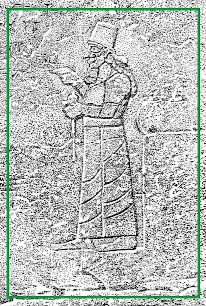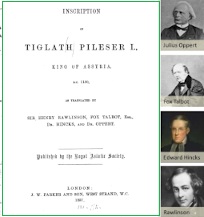Tiglath-pileser I

Börker-Klähn 1982: No. 130. See text no 15.
Quick links
Introduction
Military and political history
Building
projects
The inscriptions
Introduction
Tiglath-pileser I (1114-1076 BC) was the eighty-seventh ruler of Ashur, according to the Assyrian King List [/riao/kinglists/assyriankinglist/assyriankinglist/index.html#MiddleAss]. He was son of Ashur-resi-ishi I [/riao/ria2/ashurreshaishii/index.html] (1132-1115 BC), and reigned for thirty-nine years before being succeeded first by his son Ashared-apil-Ekur (1075-1074 BC) and, shortly after him, by his other son Ashur-bel-kala (1073-1056 BC).
With Tiglath-pileser's reign, Assyria went through times of both greatness and darkness, experiencing political and military fortunes, reaching lands as far as Babylonia in the south and Lebanon in the west, led by a powerful and charismatic ruler, who brought economic growth, and cultural transformation that would have had influence on Assyria of first millennium BC; on the other hand, the growing pressure from the aḫlamû-Arameans represented not only the hardest challenge for this and the following reigns, but even brought the Assyrians to temporarily lose their very state, being forced to flee on the mountains in order to save their lives (see below).

The importance of this king is also reflected by his presence in different types of sources, as his mentions in several king lists other than the Assyrian King List, like the fragments of the Synchronistic King List [/riao/kinglists/synchronistickinglist/index.html] (VAT 11261 and 11345 [/riao/kinglists/synchronistickinglist/fragmentsvat11261andvat11345/index.html], Ass 11338 [/riao/kinglists/synchronistickinglist/fragmentass11338/index.html]), and in the Synchronistic History (about the relations with Babylon, see Grayson, Chronicles pp. 164-165 ii 14'-24'). His reign is present, although very fragmentary, in the only Eponym List [/saao/Q004243/] in our possession, which records eponyms of the Middle Assyrian period (manuscript A7 [saao/P285503/]), and a composition in "hymno-poetic dialect" (LKA 63, see Hurowitz and Westenholz 1990), and a statue of him is listed in the Götteradressbuch of Ashur Recension B [http://oracc.org/ /] (l. 12) .
Curious for the history of the birth of Assiyriology, it was one of Tiglath-pileser I's royal inscriptions (text no. 1) that was chosen as proof-text in the experiment organised by the Royal Asiatic Society in London in 1857 that saw the four scholars, Edward Hinks, Jules Oppert, Henry Creswicke Rawlinson, and William Henry Fox Talbot, analysing independently the inscription to prove the successful stage reached in cuneiform decipherment.
Military and political history
The campaigns at the beginning of Tiglath-pileser's reign are directed north, north-west, against the pressure of the reign of Muški (Phrygia) and their occupation of the lands Alzu, Purulumzu, and Katmuḫu (text no. 1 i 62-ii 35), and to Nairi.
Problematic in the first phases of Tiglath-pileser's reign was also the southern front, where the Babylonian king Marduk-nadin-ahhe (ca. 1099–1082 BC) was able to raid into the city Ekallate and capture the statues of the gods Adad and Šala. The military campaigns that Tiglath-pileser led as reaction to this episode brought much of the southern territories under his control, including Babylon and other major urban centres, the lands between the Lower Zab and the city lubdu, and south west the region of Suḫu (text no. 4: 37-51).
A list of offerings for the Aššur Temple received during a single year from various places has been believed to be a complete list of the twenty-seven provinces of the kingdom at the moment of the redaction of this tablet (Postgate 1985, 96-101).
Under Tiglath-pileser's reign, we also have the first mention of (aḫlamû-)Arameans (and the first time the term aḫlamû is associated to this ethnic group). The king claims to have crossed the Euphrates twenty-eight times against them, but unlike what we are told in the royal inscriptions, a fragmentary chronicle seems to indicate that at least in one occasion, during a period of famine in Mesopotamia, the Arameans were able to conquer the Assyrian heartland, forcing its inhabitants to flee on the near mountains.

Tiglath-pileser is known to have had great interest in the collection of literary works. Effort was done during his reign in the collecting and copying and editing libraries of cuneiform documents of different genres, like lexical lists, divinatory texts, literary works, etc. Among them, of great relevance are the collections of palace edicts (Weidner, AFO 17 [1954-56] pp. 257-293), Middle Assyrian Laws (Meek in Pritchard, ANET3 pp. 180-188) and Assyrian Chronicles (Grayson, TLS, pp. 184-189).
To him have been attributed the collection of tablets later on stored in a Neo-Assyrian temple library from Ashur (Roth 1995) and the introduction of the particular crafting for literary tablet consisting in over baking them, which gave the distinct ivory colour of the surface, with visible reddish colour in the inner part of the tablets. However, the inauguration of the library has also been attributed to period before Tiglath-pileesr's reign (Freydank 1991) and the beginning of this procedure (restricted to the Middle Assyrian period) is still matter of debate.

Building projects
The building activities of Tiglath-pileser were concentrated at Ashur and Nineveh. At Ashur he worked on the Anu-Adad temple (texts no. 1 vii 71-114, and nos. 22-23), renovated the temple of Ninlil, rebuilt the royal "Cedar Palace," or Egallugalšarrakurkurra (no. 4) and the city walls (no. 10). At Nineveh, he restored the temple of Ištar (no. 12), worked on the city walls, and restored three palaces started but not completed by Aššur-reši-iši, one built within a garden, adorned with figurative art (sculpted or painted) of historical scenes, and one close to the Ištar temple (no. 10).
The inscriptions
The reign of Tiglath-pileser I is marked by innovation in the composition of royal inscriptions, with a mixed style of annalistic account and epic-style language focused on the ruler's heroism, and starting from this period, some new themes enter into the tradition of the genre, i.e. the royal hunt, the concern for the prosperity of the land and its people, the expansion of cultivated land, the importation of flora and fauna from the military campaigns in distant regions. Notably, some of the passages containing these new themes are found copied, sometimes verbatim, in the inscriptions of later rulers; in the introduction to text no. 1 you can see a detailed example of use of Tigalth-pileser's new motifs in later inscriptions.
Browse the RIA 3 Corpus [/riao/ria3/pager/]
Bibliography
Nathan Morello
Nathan Morello, 'Tiglath-pileser I', The Royal Inscriptions of Assyria online (RIAo) Project, The RIAo Project, a sub-project of MOCCI, 2023 [http://oracc.museum.upenn.edu/riao/thekingdomofassyria1114884bc/tiglathpileseri/]